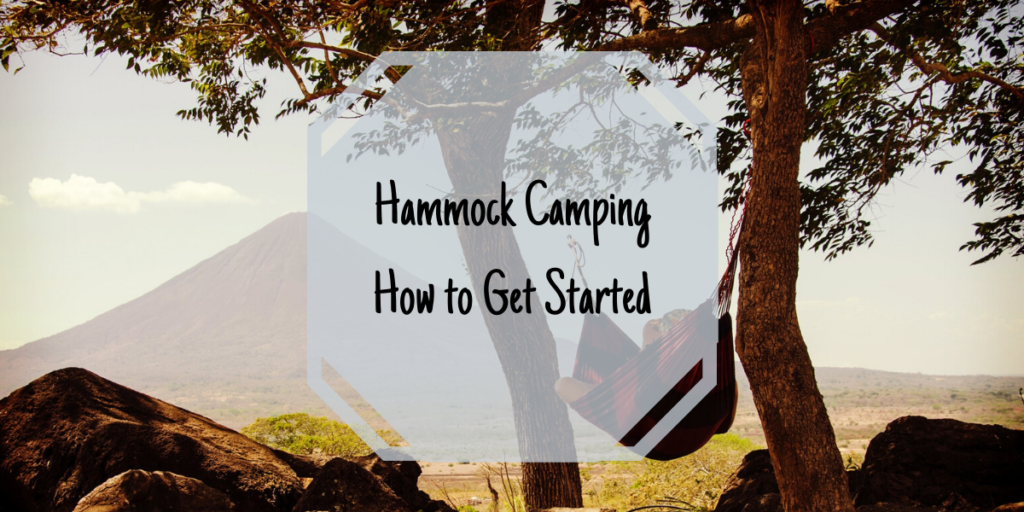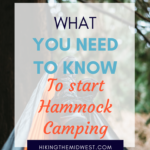Hammock camping is a great alternative to tent camping. The free floating feeling always has me sleeping like a baby. Not an easy feat considering my heart starts racing at almost every sound I hear! Is it just me or are the squirrels infinitely louder at night?

Disclaimer: this post may contain affiliate links. This means I may earn a commission
if you make a purchase using my link.
You might be asking “Why would I give up my tent”?
You don’t have to. Many hammock systems are lightweight and compact, making it easy to take it along in addition to your tent. This is a great way to go if you aren’t sure if hammock camping is for you. You can try out the hammock and if it’s not for you, you’ll have your tent to fall back on.
What are the benefits of hammock camping? Why should I try it?

Hammock camping is comfortable.
Hanging freely in the air means less pressure points on the hard ground causing pain.
You’ll never find you pitched your hammock on a stray rock or hill you didn’t notice until bedtime.
All that fresh air. Sure you can fresh air in a tent, but it’s not quite the same as the fresh air you’ll experience in your hammock.
Even stomach and side sleepers can find bliss in a hammock. If you’re a stomach or side sleeper (like me!), see my special section just for you!
An entire hammock setup can both weigh and cost less than a tent setup. With such a variety of hammock gear to choose from today, it’s easy to create a customized hammock camping setup that fits your needs and your budget.
Versatility. A hammock can be used for more than just sleeping.
Sitting on that log isn’t all that comfy after a while is it? Use your hammock as a camp chair for an elevated place to sit after a long day of hiking.
Use it as a swing. This is a bonus if you’re hiking with kids, mine love to do this.
In an emergency, a hammocks shape allows you to use it as a flag that can aid you in signaling for help or alerting rescuers to your location.
A little privacy. A hammock with a rain tarp can provide you some privacy for dressing before bed or in the morning before you prepare to leave.
You don’t have to crawl into a hammock. This means you don’t have to worry as much about tracking in dirt/mud/wetness into your temporary home like you would in a tent.
Hammock Camping Setup
Here’s what you need to hammock camp comfortably.
Hammock Of course you need a hammock to hammock camp.
Under quilt An under quilt is like a sleeping bag, only it hangs underneath your hammock, cocooning the bottom. Why do you need an under quilt? 3 words. Cold. Butt. Syndrome. The dreaded CBS. When you use a sleeping bag in your hammock, your body compresses the loft of the bag underneath you, rendering it useless. The under quilt makes up for that lost insulation by keeping lofted insulation under your body.
Rain Tarp A rain tarp provides protection from the elements. They’re not always necessary, but it’s better to have it with you in case you do need to use it.
Suspension System with Tree friendly Straps A suspension system usually consists of a rope or strap that wraps around a tree, with a ring to clip or tie your hammock to. It’s important that the suspension system be tree friendly to avoid damaging the trees you’re using. The rope that normally comes with hammocks is damaging to the tree’s bark. A safer option is to use tree straps that are at least 1inch wide. A bonus, the tree straps are generally easier to use than tying ropes.
Bug Net No one wants to become the main course for hungry bugs. This piece of gear is another that is not always necessary, but it’s nice to have in case it’s unexpectedly needed.
How to Choose Hammock Camping Gear

Choosing a Hammock
When considering which hammock will suit you best, you need to think about size and what your intended use is. Hammocks come in single (generally 4-5 feet wide) and double (generally 5-6 feet wide). I’m a pretty small 5’4 and I prefer double hammocks because they provide a little extra space in areas that a single can close in on when you lay down in it, like your shoulder area. A double provides extra space where you need it most.
Hammock Hiking
What are you planning to use the hammock for? If you’re going to be backpacking, weight may be a factor for you. A single will usually weigh less than a double, but a hammock with a higher density (or denier) fabric can alter that.
Wise Owl Outfitters make great hammocks and they’re affordable too. The hammocks come in many different color combinations so you’re sure to find one that you love. A bonus, some of their hammocks are a package deal with the suspension you’ll read about in a minute. Take a look at the package deal here.
Choosing a Rain Tarp for Your Hammock
There’s a lot of factors to consider when choosing a rain tarp, so let’s dive in.
Size
The size of your hammock directly influences the size of tarp you’re going to need. You want your tarp to extend a minimum of 6-12 inches past both ends of your hammock. Keep in mind that a hanging hammock will have a slight curve, making the area need to cover shorter. For instance a 10 foot long hammock, hanging properly, will have approximately 8 feet of length that needs covered by your tarp. This means a 10 foot long tarp would adequately cover your hammock, leaving an extra 12 inches of space overhanging each end of your hammock.
Shape

There are 5 main shapes of rain tarps. Each provides a different coverage level.
Asymmetrical Tarp
This shape is the most lightweight, but provides the least coverage.
Hexagon Tarp
These offer more coverage than asymmetrical tarps, but are not as easy to set up.
Diamond Tarps
Diamond shaped tarps are easy to set up and provide more coverage on the sides of the hammock, but the ends don’t have much coverage.
Rectangle Tarps
Rectangle tarps are heavier due to the amount of material required to make this shape. They do provide a lot of coverage, but they can be a little harder to set up than other shapes.
4 season Tarps
If you’re going to be hammock camping in winter or heavy precipitation, this is the tarp for you. They are heavy and can be difficult to set up properly, but they provide the most protection. 4 season tarps have doors that can be closed to create a hanging tent around your hammock, shielding you from fierce snow, rain, and winds.
The Ultimate Hang has a great infographic on tarp shapes, I found it helpful when choosing my own tarps.
Choosing Your Hammock Suspension System
When looking for a suspension system, you should take into consideration the following.
Tree friendly – Look for straps that are at least 1 inch wide to help protect the trees you hang from.
Adjustable – With an adjustable length, you’ll have more options when it’s time to choose your campsite.
Weight capacity – Your straps will need to hold your weight, your gear if you’re hanging from your hammock setup, your sleeping bag, sleeping pad, underquilt and anything else you may have in your hammock.
Weight of the straps– Tree straps come in a variety of weights. You’ll want to find straps that don’t add too much weight to your pack, but also fit the other factors you require.
Again, Wise Owl Outfitters has a great deal on a suspension system/hammock combo. They make great products and I recommend this package to new hammock campers because it’s both great craftmanship and budget friendly. It’s also Prime eligible so you can start trying it out ASAP.
Choosing a Bug Net
These are pretty simple to choose. You mainly want to make sure it’s large enough to cover your hammock and that it provides 360 degrees of coverage. Checking that it is made of no-see-um mesh is also a good idea, some insects are small enough to fit through mesh that isn’t.
Troubleshooting Common Hammock Comfort Issues

Are your shoulders being squeezed or your back hurting? Your hammock hang may not be quite right. To make sure you’re getting the proper hang, think like Goldilocks. Too tight is bad, so is too loose. A properly hung hammock has a slight curve in it. It should resemble a smile more than a banana.
Note- Never sleep in a bears hammock. They don’t like that.
Laying down is not comfortable. You may not be laying at the right angle. If you’re lying straight in your hammock, try lying diagonally. This may sound strange, but it helps your body lay flatter across the hammock instead of curving with the hammock.
You slide towards the middle of your hammock. Try raising your foot end slightly.
Hammock Camping Tips for Side and Stomach Sleepers
Sleeping at an angle on your hammock creates a flatter surface. This allows you to lay on your side comfortably, just as you would in your bed. I can even curl my legs up and sleep in an almost fetal position comfortably.
Try laying normally in your hammock, with your body down the center. Now move your feet and legs to one side until they feel lower than they were when you were centered. Repeat with your head but move it to the opposite side. What you’re trying to do is position your body about 30 degrees off center. This allows you to lay flat in a curved hammock.
Opt for an underquilt instead of a sleeping pad. A sleeping pad can force you to sleep at a less than ideal angle in your hammock to stay on top of it. Using an underquilt doesn’t restrict your sleeping positions.
Use a backpacking pillow. If your neck, head, knees, or hips are having a difficult time getting comfortable, using a pillow may help alleviate the issue. Use it between your knees to help keep your knees from knocking or to help keep your hips in a more natural position.
For stomach sleepers, if you’re having issues with your lower back while on your stomach, try pulling one leg slightly up while bent at the knee. This can help reduce pressure on your lower back.
I find hammocks to be more comfortable than sleeping on the ground in a tent. No matter what sleeping pad is underneath, nothing beats that zero pressure point feeling a hammock provides. Give it a go and let me know what you think!
If you have any questions, I’d be happy to help answer them. Just send me an email and I’ll get back to you ASAP.
Related Posts
